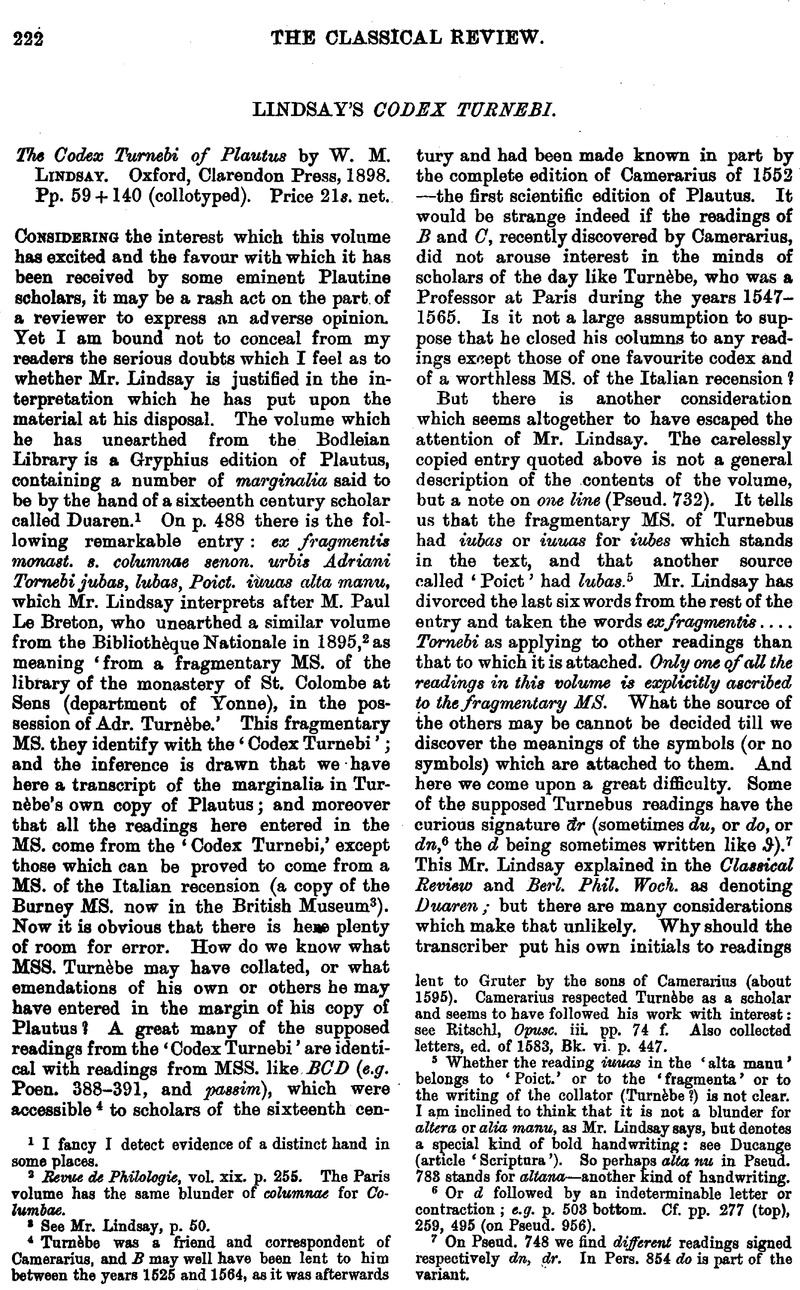No CrossRef data available.
Article contents
Lindsay's Codex Turnebi - The Codex Turnebi of Plautus by W. M. Lindsay. Oxford, Clarendon Press, 1898. Pp. 59 + 140 (collotyped). Price 21s. net.
Published online by Cambridge University Press: 27 October 2009
Abstract

- Type
- Reviews
- Information
- Copyright
- Copyright © The Classical Association 1899
References
page 222 note 1 I fancy I detect evidence of a distinct hand in some places.
page 222 note 2 Revue de PMlologie, vol. xix. p. 255. The Paris volume has the same blunder of columnae for Columbae.
page 222 note 3 See Mr. Lindsay, p. 50.
page 222 note 4 Turnebe was a friend and correspondent of Camerarius, and B may well have been lent to him between the years 1525 and 1564, as it was afterwards lent to Gruter by the sons of Camerarius (about 1595). Camerarius respected Turnebe as a scholar and seems to have followed his work with interest: see Ritschl, Opuse. iii. pp. 74 f. Also collected letters, ed. of 1583, Bk. vi. p. 447.
page 222 note 5 Whether the reading iuuas in the ‘alta mann’ belongs to ‘Poict.’ or to the ‘fragmenta’ or to the writing of the collator (Turnèbe?) is not clear. I am inclined to think that it is not a blunder for altra or alia manu, as Mr. Lindsay says, but denotes a special kind of bold handwriting: see Ducange (article ‘Scriptura’). So perhaps alta nu in Pseud. 788 stands for altana—another kind of handwriting.
page 222 note 6 Or d followed by an indeterminable letter or contraction; e.g. p. 508 bottom. Cf. pp. 277 (top), 259, 495 (on Pseud. 956).
page 222 note 1 7 On Pseud. 748 we find different readings signed respectively dn, dr. In Pers. 854 do ia part of the variant.
page 223 note 1 E.g. Poen. 977 Punicust guggast homo (Cod. Turn. Punicast, &c.)
page 223 note 2 These proportions are not materially affected some of the readings are excluded from consideration as not belonging to the Cod. Turn.; see below.
page 223 note 3 E.g. the possim in Pseud. 735 (a bad conjecture): cf. Mr. Lindsay (p. 8) on Pers. 623, 310, Poen. 30 926, Cas. 523.
page 223 note 4 In Poen. 977 the ‘lib. vet.’ also had Punicus (for Pwnicast); see ed. of 1577, p. 877.
page 223 note 5 The name of the founder of the monastery at Bobbio (Columbanus) often appears in the form Columba. See Jonas, Abbot of Bobbio in the 8th century, Life of Col. (Columbanus qui et Columba dicitur). So too in the verses quoted by Muratori, Antiq. it al. med. aev. iii. p. 826 (Sancts Columba, tibi Scoto tuus incola Dungal Tradidit hunc librum, quo fratrum corda beentur, etc. from a MS. containing Vitae Sanctorum Patrum). The monastery at Sens was named after S. Colombe, a virgin who suffered martyrdom at Sens in the 3rd century.
page 224 note 1 See Ritschl, Opusc. ii. p. 4.
page 224 note 2 The only exceptions are Cas. 640, Poen. 319. Here Turnièbe possibly referred by mistake to the wrong MS. In Pseud. 738 alis (Adv. xx. 10) agrees with A; aliis (Opusc. i. p. 64, 53) is not from the ‘schedae,’ but from a MS. which he calls ‘peruetustus’ (perhaps B, which Camerarius often describes as liber vetus.) Similarly Rud. 767, and perhaps Rud. 525. In Cas. 729 the only MS. which has μέγακακόν ‘plane et literate peracriptum’ is A, though it also has tibi, omitted by Turnèbe. In Poen. 371, 413, 471 Studemund read as Turnèbe (except in 413 minore and meo; in 471 lenullo for lenulle, and details of spelling in last word). In Poen. 1313 Turnèbe is probably quoting from the Palatine MSS. Rud. 724 Non licet etc. may well have been visible in A in the sixteenth century. It must never be forgotten that A is difficult to decipher, and probably was so even before the application of Mai's chemicals; so that some difference of opinion as to its readings may be expected. The marvel is that there are not more. [The passages in which the Cod. Turn, differs from BCD more than from A are more numerous: e g. Cas. 523, Poen. 30, 47, 580, 770, 977, 1033.]
page 224 note 3 Studemund says it is not certain that A came from Bobbio.
page 224 note 4 ‘Schedae morticinae,’ ‘quas aliquando habui’ (Adv. xv. 7); ‘aliquando in aliquot membranas peruetustas incidi, in quibus scriptus erat Poenulus’ (Adv. xix. 12). Not only, then, did Turnèbe write in haste (cursim et properanter) but he had not the MS. before him when he wrote his Adversaria.




